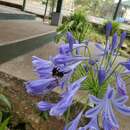fr
noms dans le fil d’Ariane


Bombus irisanensis is a rare species of bumblebee endemic to Luzon in the Philippines.[1][2]
The hair on the head is mostly black, the thorax is dorsally black and reddish-yellow on the sides. The first two segments of the abdomen are yellow and the rest are black. The legs are black and the wings are sooty colored, but "transparent enough for print to be easily read through them".[1]
The holotype specimen was collected some time between 1906 and 1910, in late May, by an unknown collector.[1][3] It was deposited in the Natural History Museum, London, and first formally named by Theodore Dru Alison Cockerell in 1910.[1] It is placed in the subgenus Bombus (Megabombus).[4] Bombus irisanensis was named for Irisan, a barangay (district) in Baguio, where it was collected.[1][3]
The first public digital record of Bombus irisanensis was added to iNaturalist in June 2019 by Paul Engler.[5] The record may be the first documentation of its continued existence since the 1990s.[2]
Several published articles note it was assessed as "Vulnerable" on the IUCN Red List.[2][6]. It was not listed on the IUCN website as of December 2020.[7]
Bombus irisanensis is a rare species of bumblebee endemic to Luzon in the Philippines.
The hair on the head is mostly black, the thorax is dorsally black and reddish-yellow on the sides. The first two segments of the abdomen are yellow and the rest are black. The legs are black and the wings are sooty colored, but "transparent enough for print to be easily read through them".
The holotype specimen was collected some time between 1906 and 1910, in late May, by an unknown collector. It was deposited in the Natural History Museum, London, and first formally named by Theodore Dru Alison Cockerell in 1910. It is placed in the subgenus Bombus (Megabombus). Bombus irisanensis was named for Irisan, a barangay (district) in Baguio, where it was collected.
The first public digital record of Bombus irisanensis was added to iNaturalist in June 2019 by Paul Engler. The record may be the first documentation of its continued existence since the 1990s.
Several published articles note it was assessed as "Vulnerable" on the IUCN Red List.. It was not listed on the IUCN website as of December 2020.
Bombus irisanensis is een vliesvleugelig insect uit de familie bijen en hommels (Apidae). De wetenschappelijke naam van de soort is voor het eerst geldig gepubliceerd in 1910 door Cockerell.[1]
Bronnen, noten en/of referentiesBombus irisanensis[2][3][4] är en biart som beskrevs av Cockerell 1910. Den ingår i släktet humlor och familjen långtungebin.[5][6] Inga underarter finns listade.[5]
Grundfärgen är svart med röda bakskenben och -fötter. Pälsen på huvud och mellankropp är övervägande svart, men med röda markeringar kring mundelarna och gulbrun päls på mellankroppens sidor. De två första segmenten på bakkroppens ovansida (tergiterna) är varmt gula, resten av bakkroppen är svartpälsad. Vingarna är mörka, men genomskinliga. Längden är omkring 14 mm.[7]
Arten finns på Filippinerna.[8]
Bombus irisanensis är en biart som beskrevs av Cockerell 1910. Den ingår i släktet humlor och familjen långtungebin. Inga underarter finns listade.
Bombus irisanensis là một loài Hymenoptera trong họ Apidae. Loài này được Cockerell mô tả khoa học năm 1910.[1]
Bombus irisanensis là một loài Hymenoptera trong họ Apidae. Loài này được Cockerell mô tả khoa học năm 1910.